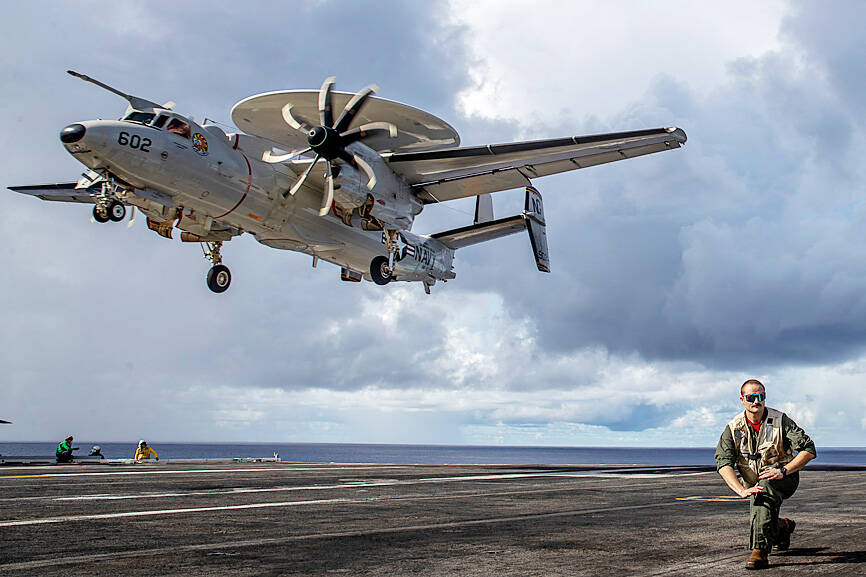The government is planning a special budget, estimated at up to NT$500 billion (US$16.5 billion), for military purchases from the US, a high-level government official said yesterday on condition of anonymity.
The planned special budget would be in addition to a draft special act aimed at bolstering economic, national security and social resilience, they added, referring to Executive Yuan spokeswoman Michelle Lee’s (李慧芝) call on Wednesday for the Legislative Yuan to support the Cabinet-proposed special act, which has set aside NT$150 billion to bolster national defense resilience. The NT$150 billion is part of the NT$410 billion that the Executive Yuan proposed on April 24 in response to ramped-up US tariffs.
The Ministry of National Defense (MND) is still in talks with the Executive Yuan on the budget amount and in talks with the US on what equipment to purchase, and the actual budget amount has not been set, the official said.

Photo: Reuters
The ministry is looking at about NT$300 billion to NT$500 billion, which would be over five years, they said, adding that the budget plan would be delivered to the Legislative Yuan before the next legislative session.
The special budget amount was set to meet the goal of increasing annual defense spending to 3 percent of GDP, they added.
For this fiscal year, the Cabinet had earmarked NT$647 billion for national defense, amounting to 2.45 percent of GDP.
President William Lai (賴清德) has pledged to propose a special budget to raise defense spending to more than 3 percent of GDP.
In March, then-US undersecretary of defense for policy nominee Elbridge Colby during a confirmation hearing at the US Senate Committee on Armed Services said Taipei should raise defense spending closer to 10 percent of GDP.
The official remained tight-lipped regarding what kind of equipment would be purchased with the special budget — such as E-2D Hawkeye aircraft — adding that the details would be made known when it is finalized.
Regarding the NT$150 billion from the proposed NT$410 billion for bolstering national defense resilience, Lee has said the Executive Yuan hopes to use it to increase budgets for the Coast Guard Administration to build new ships capable of conducting patrolling duties during inclement weather and reinforce the coast guard’s capabilities in countering China’s “gray zone” tactics.
Uncrewed aerial vehicles of different types are to be acquired under the budget to bolster patrolling capabilities in the littoral regions and up to 24 nautical miles (44.4km) from the coast, she said.
The budget would also fund the establishment of a collaborative platform for the military to consolidate information from multiple sources, providing improved and encrypted communications in real-time with units, she said.
The budget would also fund the building of data centers for data redundancy that would allow core military functions to continue operations in times of emergency, Lee said, adding that the budget would also fund efforts to ensure the stable operations of servers, systems and services.

TRAGEDY STRIKES TAIPEI: The suspect died after falling off a building after he threw smoke grenades into Taipei Main Station and went on a killing spree in Zhongshan A 27-year-old suspect allegedly threw smoke grenades in Taipei Main Station and then proceeded to Zhongshan MRT Station in a random killing spree that resulted in the death of the suspect and two other civilians, and seven injured, including one in critical condition, as of press time last night. The suspect, identified as a man surnamed Chang Wen (張文), allegedly began the attack at Taipei Main Station, the Taipei Fire Department said, adding that it received a report at 5:24pm that smoke grenades had been thrown in the station. One man in his 50s was rushed to hospital after a cardiac arrest

SAFETY FIRST: Double the number of police were deployed at the Taipei Marathon, while other cities released plans to bolster public event safety Authorities across Taiwan have stepped up security measures ahead of Christmas and New Year events, following a knife and smoke bomb attack in Taipei on Friday that left four people dead and 11 injured. In a bid to prevent potential copycat incidents, police deployments have been expanded for large gatherings, transport hubs, and other crowded public spaces, according to official statements from police and city authorities. Taipei Mayor Chiang Wan-an (蔣萬安) said the city has “comprehensively raised security readiness” in crowded areas, increased police deployments with armed officers, and intensified patrols during weekends and nighttime hours. For large-scale events, security checkpoints and explosives

A car bomb killed a senior Russian general in southern Moscow yesterday morning, the latest high-profile army figure to be blown up in a blast that came just hours after Russian and Ukrainian delegates held separate talks in Miami on a plan to end the war. Kyiv has not commented on the incident, but Russian investigators said they were probing whether the blast was “linked” to “Ukrainian special forces.” The attack was similar to other assassinations of generals and pro-war figures that have either been claimed, or are widely believed to have been orchestrated, by Ukraine. Russian Lieutenant General Fanil Sarvarov, 56, head

PUBLIC SAFETY: The premier said that security would be tightened in transport hubs, while President Lai commended the public for their bravery The government is to deploy more police, including rapid response units, in crowded public areas to ensure a swift response to any threats, President William Lai (賴清德) said yesterday after a knife attack killed three people and injured 11 in Taipei the previous day. Lai made the remarks following a briefing by the National Police Agency on the progress of the investigation, saying that the attack underscored the importance of cooperation in public security between the central and local governments. The attack unfolded in the early evening on Friday around Taipei Main Station’s M7 exit and later near the Taipei MRT’s Zhongshan